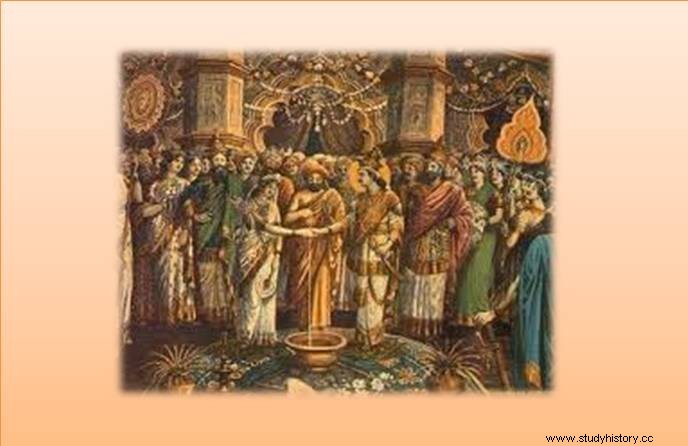
Punchmarks or hammered coins found from Buddhist viharas were found tied in a cloth. The fabric was tested by Turner and Gulati firm of Bombay. Both these firms concluded that this cloth is of the same period i.e. Mauryan period.
Monk's Stuff
The remains of shiny alms pots, soil made plates, worship pots etc. have also been found from here. Pans with a shape similar to a snake's hood, clay pots made with holes for incense, idols of dancers and yakshas and soil made basebals have also been found, on which the marking of the kathara is found.
Evidence of Tantra-Mantra
Materials obtained from Bairath included iron nails, small stone panels with oval circular thin folds, which were used as amulets. An idol of a dancing Yakshini has been found from here whose head and legs are unavailable. Its left hand is on the hip and the right hand is on the chest to handle the left breast. This idol is naked and is wearing a garland of three strings on the waist. Similar sculptures have been found from railing pillars in Mathura which date back to the first century BC.
iron factory
An iron factory was located near the Buddhist monastery of Bairath. In this, iron tools were made to meet the needs of the people of the monastery. Bend pieces of iron, nails, fish plates with nails fixed on them, etc. have been found in large numbers. Many other types of iron objects have been found.
Nails of various sizes, small rods, large iron strips with nails fixed on their wide edges, iron sand, bundles of metal tapes and only the tip of an arrow and the needle have also been found. A copper match has been found which is deep on both the sides. It is like a matchstick to remove dirt from the ear.
Brahmi script script
A smooth Chunar stone slab has also been found at some distance from the site of this material. From the ditch of the northern side of the temple, that part of the upper edge of the earthen pot was also found on which the inscription is inscribed in Brahmi script.
Four Levels Aaye Light
Four levels of Bairath's civilization have come to light. The first excavation was done by Dayaram Sahni. The second excavation was done by Nilaratna Banerjee and Kailashnath Dixit. From the second excavation, gray painted pottery, North Indian Krishna Marjit pottery and important remains of ancient era were found. This excavation brought to light four levels that revealed the cultures of four different eras.
The lowest level, that is, the first inhabitants of this place, used painted gray vessels. This was followed by those using northern black polished vessels. From the third level, people using characters from the early Christian era culture lived. Medieval glazed lacquered characters have been found from the fourth level.
Hiuan Tsang had seen 8 Buddhist Viharas
The Chinese Chatri Hiuen Tsang had seen 8 Buddhist monasteries in this area, of which 7 are yet to be traced. Waensang has written the name of this place as 'Polio Tolo'. This place must have been quite famous at the time of his arrival i.e. in the seventh century AD. That is why Hiuen Tsang must have visited this place. According to the plan according to which Ashoka had got the inscriptions installed, 128 inscriptions would have been installed near these 8 Buddhist viharas, but so far only 2 inscriptions have been received.
It can be estimated that due to the 8 Buddhist viharas together, how widespread the influence of Buddhism must have been in this entire region. According to an estimate, these Buddhist viharas may be under the mound on which the city is currently situated.
Fall of the Maurya Empire
In these viharas, the monks were given free food, clothing, shelter and security without any effort. There was also respect from the society, so instead of becoming soldiers or farmers, people became Buddhist monks. The Mauryan armies became weak as a large number of young men became monks. Due to this the very basis of the Maurya Empire collapsed. In 184 AD, Brihadratha's minister and general Pushyamitra Shunga killed Brihadratha and himself became the king of Magadha.
Shung Carpet Relics
The Shunga dynasty ruled in 184 BC. to 72 BC Ruled Magadha during the period up to Pushyamitra Shunga, the founder of the Sunga dynasty, was a Brahmin and considered it more preferable to patronize his own religion than Buddhism. Suratgarh is an ancient town situated 78 km away from Ganganagar district headquarter. There was an old fort of Johi, which was famous by the name of Sodhal. Bikaner King Surat Singh built a new fort here in AD 1799, which was named Suratgarh.
For this reason Sodhalgarh came to be known as Suratgarh. Most of the bricks for the new fort of Suratgarh were brought here from nearby Buddhist places. Many antiquities made of clay obtained from Buddhist places were kept in Bikaner fort. In these, figures of Hadjora leaves, Garuda, elephant, demon, etc. were made. The impression of Gandhara style is clearly visible on this material.
The Gandhara style developed from a mixture of Indian and Greek sculptures, which gave a distinctive shape to the statues of Lord Buddha. The animal and vegetable figures found from the mound called Rangmahal in Ganganagar district, different forms of male and female, their various costumes and ornaments, curly hair and taut mustache are good examples of vitality and naturalness. Along with the idols of Lord Buddha, Lord Mahavir, Shankar and Krishna idols have also been found from this mound, which are of clay and stones.
